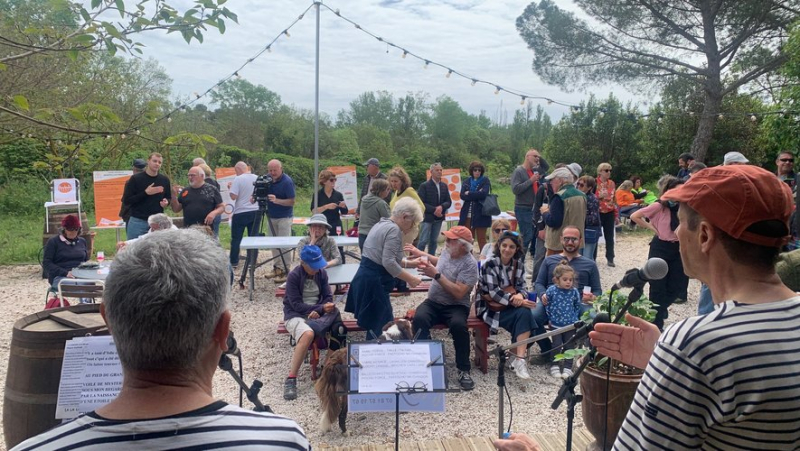Montpellier-Perpignan high-speed line: LGV Thau alert calls on SNCF on the possibility of another route

Un moment musical a ponctué ce rassemblement organisé au domaine de Creyssels, à Mèze. – V. G.
Si l’espoir est mince, l’association croit à un projet différent de celui de la SNCF pour relier Montpellier à Béziers.
They continue to believe it. Activists from the Alerte LGV Thau (ALT) association brought together around a hundred people on Saturday at the Creyssels estate, in Mèze, for a shared moment, a walk and several speeches. A way of reminding that the collective is still active, attentive to the evolution of the subject of New Montpellier-Perpignan Line (LNMP), and of affirming that resignation is, to date, not an option.
"We campaign with intelligence and by putting things in context"
There would however be reasons to doubt a step backwards on this railway project whose origins date back to the 1990s. ALT, which is interested in phase 1 of the project between Montpellier and Béziers, alert since the end of 2021 on the consequences to be expected in the Thau basin. In the collective's line of sight, we find in particular "the viaduct 20 to 28 meters high and 1.4 km long in Poussan", "the risk of pollution of the Thau pond in the event of ;accident", "the 17 drinking water catchment areas affected by the project (thus that of Issanka)", "the digging of the Gardiole" ; or "the impact on 55 sites of the Natura 2000 network". Knowing that the Sète station would be deprived "at 80 % of TGV traffic".

The route of the first phase and the most sensitive areas.
In reality, ALT claims the usefulness of a new line. "We are aware that the current line, on the coast between Sète and Agde, is not viable over 50 years due to rising water levels"< /em>, specifies Félix Caron, president of ALT. However, the current project seems "unthinkable" and the association repeats its opposition with determination.
Another proposed route
"We're not like “anti” die-hards, the president defends. We campaign intelligently and by putting things in context. The SNCF is based on a public debate dated 2009, with the aim of running passenger TGVs up to 320 km/h between Montpellier and Perpignan. For trains to reach this speed, the straight line must be straight. It therefore crosses sensitive areas and contributes to the creation of several viaducts. We are proposing a route designed for train circulation at 220 km/h, while respecting the environment, our heritage and our landscapes." A a route which would be more winding to avoid risky areas, and would withstand unevenness to avoid the creation of railway viaducts.
“Meeting the needs of tomorrow”
For the SNCF, the new Montpellier-Perpignan Line is the "last remaining link à build"to ensure continuity high speed between France and Spain. A line, she recalls, included among the priorities retained by the State in the Mobility Orientation Law of 2019. This new section ;on rail is necessary, indicates the SNCF, "to meet the travel needs of tomorrow" : the road networks, including the A9 motorway, "are today saturated", and the current railway line "cannot already be implemented. no longer accommodate additional traffic". If phase 1 was completed declared useful public on February 16, 2023, the ALT association filed an appeal for annulment with the Council of State in April. On its dedicated website, the LNMP displays the start of work on phase 1 "before the end of 2029" for commissioning "à the horizon 2034". Total cost: €6.12 billion (2.04 billion euros for phase 1 alone).
To date, this option has not attracted the attention of the SNCF. "In fifteen years, circumstances have changed sufficiently for a debate to be relaunched", believes, for her part, the Montpellier lawyer Hélène Bras, who defends the association. She participated, on Friday, in a meeting of the intercommunal land development commission (CICAF), in the presence of farmers, services of the Department of Hérault and an office of ;studies. The opportunity to learn that SNCF is looking for 1 800 ha as part of ERC measures (to Avoid, Reduce, Compensate, aimed at reduce the loss of biodiversity). It’s still worrying about their intentions."
Public inquiry in… 2027
If Sète Agglo is among the financiers (12.4 M€) of the LNMP, several mayors of the Agglo support the ALT proposal, including Josian Ribes, the mayor of Montbazin, present Saturday morning in Mèze. "I have supported it from the beginning, within the framework of the charter of the Pays de Thau Observatory. We are told that we will have to pay for a line that will not provide any service to the region, without even creating a station! All this to save 18 minutes on a Perpignan-Paris…"
Design studies are still in progress, pending a new public inquiry into civil engineering… in 2027.
I subscribe to read more




